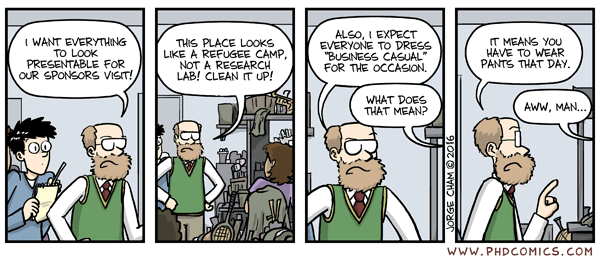So you’re presenting a poster at convention – congrats! Now what? If you’re new to research posters here are some handy tips about poster design and printing to get you started:

APAGS Poster Session at the 2015 APA Convention in Toronto.
Poster Design
Size & Design – The first task will be to figure out how big you want your poster to be and what program you’ll be using to design it. The acceptance letter will tell you the size of board you have to put your poster up on – I would recommend choosing a size that is slightly smaller than this. For example, if the letter states 4ft x 6ft, you might want to print 3ft x 5ft. Poster design websites (e.g., posterpresentations.com) will have downloadable templates in standard sizes that will get you started. If you want to design your poster sans template, people typically use Microsoft Powerpoint and design their poster on a single slide. The important part here is to adjust the size of the slide to the size you want to print (Design > Page Set Up > Custom – this may vary depending on your version of the program).
Keep it simple – The next step is figuring out what to put on your poster. Less is more! Think about your research question and take-home message and design your poster around this. Many people will be passing through quickly and the goal is to present your findings at a glance. I know it’s hard to cut out detail, but remember that you’ll be there to answer any questions about methods, measures and minutiae that come up!
Be creative, but keep it thematic. If you can adapt your findings or present your materials in a visual format – go for it! Just be sure to label everything clearly and include only the information that is crucial to your message. You don’t want the visual elements to distract from or undermine the message.
Poster Printing
After you design your poster, it’s time to get it printed! Many universities and colleges have in-house printing services, and most college towns will have print shops with competitive prices on research posters. There are also several websites that specialize in printing research posters. These have the added bonus that you can have your poster delivered right to your hotel at convention. While I’ve never had issues with this before, I would be wary of this method if I was presenting near the beginning of convention (to give you time to re-order if it didn’t arrive).
Another thing to consider is if you want to print a paper poster, which is traditional, or go with a fabric or digital poster. I haven’t seen many digital posters, but think this option could be beneficial if you want a cheap and interactive display. If you are interested in going digital, first check that it’s an option that will be available to you, and second, make a contingency plan in the case of technical glitches (e.g., have extra printed copies of the poster, have the contact information for A/V support on site, etc.). Fabric posters can be more expensive, but they’ve been coming down in price. These can be great if you’re traveling a long distance and want the convenience of putting your poster in your suitcase or convention bag. With this option, you may need to iron your poster to take out any creases due to the folding.
Other Considerations
Print letter-sized copies of your poster for people to take with them, or at the very least, have a place for people to leave their contact information for you to send digital copies (or have a QR code for people to scan).
Also, think about how you’ll transport your poster to convention. If you’re printing a paper poster, will you need a poster tube? If you’re flying and bringing a tube as a carry-on, consider sharing the tube (and any luggage fees) with a friend. Also, think about the logistics of carrying your poster tube plus whatever else you’re bringing to convention (e.g., briefcase, shoulder bag) to ensure its manageable.
Lastly, posters are one of the areas where academics get to show off their creative side. Have fun with it!
 Woohoo! You’re attending the 2017 APA Convention in Washington, DC. But before the fun can begin, you have to figure out how to get to Convention and where to stay once you arrive. Thankfully, the APA website has lots of helpful info and this post will help point you in the right direction (there’s also some travel humor for you, BTW).
Woohoo! You’re attending the 2017 APA Convention in Washington, DC. But before the fun can begin, you have to figure out how to get to Convention and where to stay once you arrive. Thankfully, the APA website has lots of helpful info and this post will help point you in the right direction (there’s also some travel humor for you, BTW).




